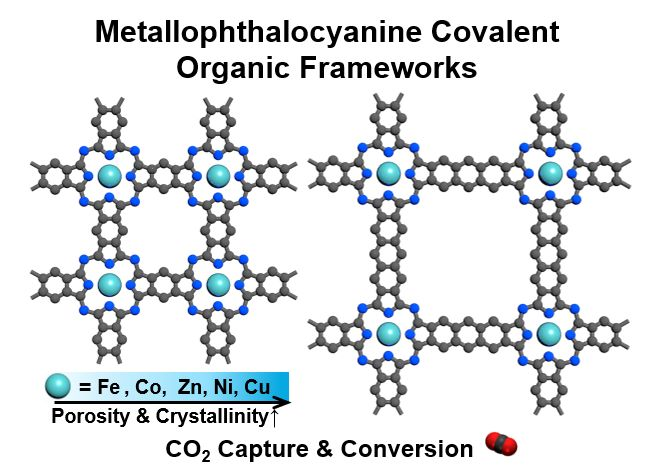Mixed-metal Ionothermal Synthesis of Metallophthalocyanine Covalent Organic Frameworks for CO2 Capture and Conversion
Phthalocyanines (PCs) are macrocyclic compounds containing nitrogen-bridge, and their chemical property and stability are tuned by the coordinated metal ions. The metallophthalocyanines (M-PCs) have been investigated in various chemical reactions including electrical-photochemical CO2 reduction since the coordinated metal atom acts as a catalytic active site in the reaction. Therefore, their polymeric counterparts featuring extended conjugated backbones have gained significant interest as heterogeneous catalysts and PC-containing frameworks such as covalent organic frameworks (COFs) have been widely investigated for CO2 capture and conversion [1]. General solvothermal reaction methods for PC-based frameworks cause low-crystallinity of frameworks due to the high stability of the linkers, and require an expensive catalyst, organic solvent, and additional work-up steps to purify it. Therefore, a novel and environmentally friendly synthetic approach for high crystallinity of PC-based frameworks is required.
Herein, we show the innovative synthesis strategy using the mixed metal salt (MCl2/ZnCl2, M = Cu2+, Ni2+, Co2+, and Fe2+) in the ionothermal synthesis of Phthalocyanine based Covalent Organic Frameworks (COFs) which called PPC (Porous polyphthalocyanines). We hypothesized that mixed metal salt mixtures (MCl2/ZnCl2) would result in PPC including desired metal ions, which has a higher complex stability than that of the Zn-phthalocyanine according to the Irving-Williams series, which predicts the relative stability of complexes formed by transition metals that increases when moving in the periodic table from Fe2+ to Cu2+. In the end, we found a clear correlation between the Irving-Williams series and the metal content, surface area, and CO2 adsorption capabilities of PPCs. This result provides a tunable approach to designing these polymer properties. Noticeably, with surface areas as high as 2043 m2g-1 and CO2 uptake capacities up to 7.6 mmol g-1, these polymers exhibit significant potential for CO2 application. In addition, We also investigated the growth of the Co-pPPC and Co-anPPC on highly conductive carbon nanofibers and demonstrated their high catalytic activity in the electrochemical CO2 reduction, which show Faradaic efficiencies towards CO of up to 74% at -0.64 V vs. RHE.
